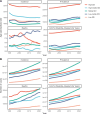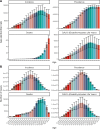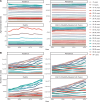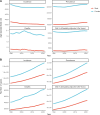From Pain to Progress: Comprehensive Analysis of Musculoskeletal Disorders Worldwide
- PMID: 39469334
- PMCID: PMC11514690
- DOI: 10.2147/JPR.S488133
From Pain to Progress: Comprehensive Analysis of Musculoskeletal Disorders Worldwide
Abstract
Objective: Comprehensive analyses of the burden of musculoskeletal disorders (MSDs) are crucial for deepening our understanding of their impact on population health and for evaluating progress toward achieving international health goals.
Study design: A comprehensive analysis was performed using data from the Global Burden of Diseases, Injuries, and Risk Factors Study (GBD) 2021.
Methods: We gathered data on the number of prevalent cases, incidences, deaths, and disability-adjusted life years (DALYs) for MSDs from 1990 to 2021. Subsequently, crude indicators, age-standardized rates (ASRs) and estimated annual percentage change (EAPC) were calculated for MSDs from 1990 to 2021 at the global, regional, national, age and gender levels. Finally, decomposition analysis, frontier analysis, and EAPC cluster analysis were employed to examine changes in the indicators and the factors influencing them.
Results: In 2021, there were 367,193,430 incident cases and 1,686,561,517 prevalent cases of MSDs globally. Between 1990 and 2021, the age-standardized incidence rates (ASIR) declined marginally from 4641.5 to 4351.79 cases per 100,000 population [EAPC: -0.16 (-0.19 to -0.13)], while the age-standardized DALY rates (ASDR) increased from 1886.2 to 1908.87 per 100,000 population [EAPC: 0.09 (0.07 to 0.11)]. The ASRs were markedly elevated in the high SDI regions in comparison to the remaining SDI regions. The EAPC and its phase clustering analyses indicated a notable upward trajectory in the burden of MSDs in the low and middle SDI regions, particularly in Central Asia. The prevalence of MSDs is highest among individuals aged 50-59 years and among women. At the global level, the burden of MSDs is 1.43 to 2.30 times higher for women than for men.
Conclusion: From 1990 to 2021, the burden of MSDs has been concentrated in high SDI regions, with a gradual shift towards low and middle SDI regions.
Keywords: DALYs; epidemiology; global burden of disease; incidence; musculoskeletal disease; prevalence.
© 2024 Zhou et al.
Conflict of interest statement
The authors declare that they have no conflict of interest.
Figures












References
-
- Steinmetz JD, Culbreth GT, Haile LM; GBD 2021 Osteoarthritis Collaborators. Global, regional, and national burden of osteoarthritis, 1990-2020 and projections to 2050: a systematic analysis for the global burden of disease study 2021. Lancet Rheumatol. 2023;5(9):e508–e522. doi:10.1016/S2665-9913(23)00163-7 - DOI - PMC - PubMed
LinkOut - more resources
Full Text Sources

